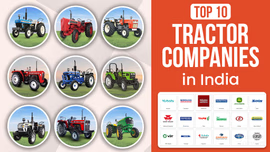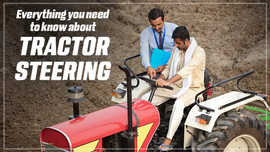The Working of Hydraulic Systems in Tractors

Table of Contents
- Introduction
- What are the Components of a Hydraulic System
- How Does a Hydraulic System Work
- What are the Types of Hydraulic Systems in Tractors
- What are the latest Hydraulic Systems used in Tractors
- Directional Control Valve (DCV)
- Final Words
Introduction
A tractor's work is to provide more useful performance on the field, which leads to the hydraulics application to achieve different field operations, such as tilling, harrowing, ploughing, sowing, interculture, etc., quickly. A tractor's hydraulic system plays an important role in powering various implements, lifting heavy loads, and performing many other tasks.
The basic definition of a hydraulic is that it is a mechanism in tractors to lift, lower and hold the attached or semi-attached implements. The hydraulic system is available in all tractors to control the operation of three-point hitch. The hydraulic engineering through which we all are familiar is called hydrostatics. It is the ability to transmit force or motion using a fluid which is confined. Let's discuss the components, working, and types of hydraulic systems.
What are the components of a hydraulic system?
- Hydraulic pump
- Hydraulic tank
- Hydraulic cylinder and piston
- Safety valve
- Control valve
- Lifting arms
- Hose pipe and fittings
How does a hydraulic system work?
The working of a hydraulic system is based on Pascal's law. According to this law, the pressure applied to an enclosed fluid is transferred equally in every direction. A small force acting on a small area can generate a high force on the surface of a large area. The working of a hydraulic system involves the operation of all its components:
Operation: The operation starts with a hydraulic pump, which draws up oil from the oil reservoir and transfers it to the control valve under extreme pressure. After that, the oil goes from the control valve to the hydraulic cylinder to operate the piston, which further raises the lifting arms. The hydraulic system's lifting arms are further attached to the implements.
Let's discuss the different components of a hydraulic system:
Hydraulic Pump: Different types of hydraulic pumps are there, such as gear pump, vane pump, plunger pump, and screw pump. Gear pumps can flow a larger amount of oil than a plunger pump, which is why they are widely used in tractors. The pump's oil pressure varies from 150 to 200 kg/cm3.
Hydraulic Tank: This is used to store hydraulic oil in the system. In some tractors, the transmission chamber works as the hydraulic tank, and the same oil is used for the hydraulic and transmission systems. In some tractors, the hydraulic oil is stored in a separate tank.
Hydraulic Cylinder: It is a big cylinder-type structure equipped with a piston and a connecting rod. It is also known as a ram cylinder. The connecting rods are used to transmit power from the piston to the lifting arms. Then, the piston starts moving in the hydraulic cylinder and creates a reciprocating motion. The lifting arms are raised because of the hydraulic pressure while lifting the implements but lowering is done by its own weight.
Control Valve: It is used to control the hydraulic oil movement to determine the desired route, magnitude, and lifting speed. Thus, it performs three functions, including changing the direction, power, and speed of lifting.
Oil Filter: It is a small filter present at a suitable position in the oil passage, used to filter the oil and make it free from impurities.
What are the types of hydraulic systems in Tractors?
The hydraulic system in tractors uses three methods: position control, draft control, and mixed control.
Position Control: The position control maintains constant ploughing depth using automatic adjustment of the draft of the tractor. In this system, the operator can operate the control valve directly to lower, raise, and hold the implement attached to the linkage at any preferred height.
Draft Control: In this type of hydraulic system, any implement's working depth can be controlled continuously without the depth wheel's requirement on the implement. The hydraulic control valve reacts to the changes in the loading in either the top or lower links, which arc because of the changes in the draft or pull required by the implement. If any implement goes too deep in the soil, its draft rises. This rise in the draft is sensed through the top or lower links. The control system then lifts the implement till the draft comes back to the present level, and the implement comes to the original depth again with the help of the draft control system.
What are the latest Hydraulic Systems used in Tractors?
Hydraulic control in the tractor was not in vogue until the 1930s'. Harry Ferguson used the first hydraulics in tractors in the United Kingdom. With the advancement in hydraulics technology, its use in tractors has also increased.
Advanced hydraulics control systems like Automatic Depth and Draft Control (ADDC) and Electric Quick Raise and Lower (EQRL) are primarily used in tractors nowadays. Let us discuss them in brief.
Automatic Depth and Draft Control (ADDC)
It automatically adjusts the depth and draft of attached implements to optimize performance and reduce operator workload. Two types of ADDC are primarily used in tractors. These are Lift-O-Matic or Auto Lift and Sensi-1.
- Lift-O-Matic can lift and lower the implement to the previous depth position while turning without a draft control lever. New Holland Tractors primarily come with this hydraulic control system.
- Sensi-1 lift technology uses the Sensi-1 point of the top link to enable the tractor to lift heavy implements for uniform cultivation and enhance productivity. This hydraulics technology is primarily used in Powertrac Tractors.
Electric Quick Raise and Lower (EQRL)
EQRL hydraulics control system usually come in John Deere Tractors. The operator can quickly hitch and unhitch the implements without operating the draft control and position control lever. It helps maintain uniform depth and position throughout the field.
Directional Control Valve (DCV)
The directional control valve, commonly known as DCV, is used to control the fluid flow in the system by identifying when and where the fluid moves. It is used to control cylinder-type actuators. The DCV can either be a check valve, rotary or spool valve, etc. The spool type of DC valve is provided in most Indian tractors. Depending on the type of circuit, the valve can be open or closed centre type. A spool valve is used to control the direction of the hydraulic fluid flow. It features cylindrical spools, which are used to open and block the channels in the hydraulic system.
Final Words
The hydraulic system is a crucial feature in a tractor that ensures the efficient and precise performance of implements in different field conditions. Farmers must have a total understanding of its working and maintenance so that they can fully utilize their tractor's capability. Continuous innovation in technology has resulted in advanced hydraulic controls for more efficient performance. You can check out Tractorkarvan to get the list of different tractor models that come with the latest hydraulic controls.


Related Blogs












